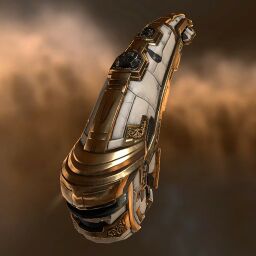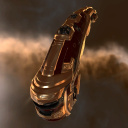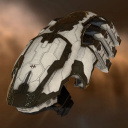Difference between revisions of "Inquisitor"
m |
(→Summary: fleshing this section out) |
||
| Line 76: | Line 76: | ||
==Summary== | ==Summary== | ||
| − | The Inquisitor is the Amarr | + | The Inquisitor is the Amarr [[Frigates#Logistics_Frigates|Logistics Frigate]]; Inquisitor pilots repair their fleetmates’ ships during battle. The Inquisitor is bonused for remote armor repair, which matches the Amarr racial focus on armor tanking. The ship’s bonuses to remote armor repairer amount, activation, and range make the underwhelming base stats of small remote armor repairers practically useful. Flying the Inquisitor is a great first step in learning about [[Logistics]]. Inquisitor pilots often go on train into heavier Tech I logistics cruisers (such as the Amarr [[Augoror]]), and then Tech II logistics ships (including the [[Deacon]] and [[Guardian]]). But the Inquisitor is also effective all on its own, especially as a component of frigate or destroyer gangs, where speed is key. |
| − | + | One defining challenge of flying Tech I logistics frigates in general, and the Inquisitor in particular, is sustaining enough capacitor to run the ship. Remote repair modules are extremely cap-intensive, so the Inquisitor is typically fit to boost available capacitor—with a cap recharger or booster in a mid slot, capacitor control circuit or remote repair augmentor rigs, and, if necessary, “Enduring” remote armor repairers (which consume less cap). Training character skills that boost capacitor will also help. It might seem that fitting the Inquisitor with an afterburner instead of a microwarpdrive (MWD) could spare some capacitor. But the Inquisitor needs to keep up with its small-ship fleetmates in order to repair them, so it really needs an MWD. Pilots fitting the Inquisitor should use the in-game fitting simulation window, or an out-of-game tool like [[Pyfa]], to match any fit to their specific skills and to gauge the ship’s cap stability. (This also means you may need to swap out modules on any pre-fit Inquisitor hulls that you purchase on corp contracts, to make them work with your skills.) | |
| + | |||
| + | The Inquisitor has more tank and more native capacitor than any other Tech I logistics frigate, which make it a particularly effective logistics frigate. The Inquisitor and the [[Deacon]], its Tech II cousin, are favored over the other racial frigates in gangs of small armor-focused damage-dealers (such as the [[Confessor]], [[Coercer]] or [[Punisher]]). The Inquisitor is also a great ship for younger players to participate in small-ship shattered wormhole ([[Shattered_wormhole_systems#Standard_Shattered_Wormhole_Systems|C13]]) PvE. | ||
==Skills== | ==Skills== | ||
Revision as of 16:37, 6 August 2017

RELATED UNI-WIKI REFERENCES
|
In YC114 each major empire faction, having been embroiled in a harrowing, extensive, long-term war, recognized the growing need for support and logistics functionality in their vessels during the kind of protracted interstellar warfare that might otherwise prove exhausting for its participants. In the Amarr Empire, this led to the redesign and redeployment of the Inquisitor. SHIP BONUSES
Amarr Frigate bonuses (per skill level):
Ship Attributes
|
Summary
The Inquisitor is the Amarr Logistics Frigate; Inquisitor pilots repair their fleetmates’ ships during battle. The Inquisitor is bonused for remote armor repair, which matches the Amarr racial focus on armor tanking. The ship’s bonuses to remote armor repairer amount, activation, and range make the underwhelming base stats of small remote armor repairers practically useful. Flying the Inquisitor is a great first step in learning about Logistics. Inquisitor pilots often go on train into heavier Tech I logistics cruisers (such as the Amarr Augoror), and then Tech II logistics ships (including the Deacon and Guardian). But the Inquisitor is also effective all on its own, especially as a component of frigate or destroyer gangs, where speed is key.
One defining challenge of flying Tech I logistics frigates in general, and the Inquisitor in particular, is sustaining enough capacitor to run the ship. Remote repair modules are extremely cap-intensive, so the Inquisitor is typically fit to boost available capacitor—with a cap recharger or booster in a mid slot, capacitor control circuit or remote repair augmentor rigs, and, if necessary, “Enduring” remote armor repairers (which consume less cap). Training character skills that boost capacitor will also help. It might seem that fitting the Inquisitor with an afterburner instead of a microwarpdrive (MWD) could spare some capacitor. But the Inquisitor needs to keep up with its small-ship fleetmates in order to repair them, so it really needs an MWD. Pilots fitting the Inquisitor should use the in-game fitting simulation window, or an out-of-game tool like Pyfa, to match any fit to their specific skills and to gauge the ship’s cap stability. (This also means you may need to swap out modules on any pre-fit Inquisitor hulls that you purchase on corp contracts, to make them work with your skills.)
The Inquisitor has more tank and more native capacitor than any other Tech I logistics frigate, which make it a particularly effective logistics frigate. The Inquisitor and the Deacon, its Tech II cousin, are favored over the other racial frigates in gangs of small armor-focused damage-dealers (such as the Confessor, Coercer or Punisher). The Inquisitor is also a great ship for younger players to participate in small-ship shattered wormhole (C13) PvE.
Skills
Remote Armor Repair Systems I
Energy Grid Upgrades II
Afterburner I
Hull Upgrades II
Fitting
Small Coaxial Compact Remote Armor Repairer
Small Coaxial Compact Remote Armor Repairer
Small Coaxial Compact Remote Armor Repairer
Small Capacitor Booster II
1MN Y-S8 Compact Afterburner
400mm Rolled Tungsten Compact Plates
Adaptive Nano Plating II
Adaptive Nano Plating II
IFFA Compact Damage Control
Small Anti-Explosive Pump I
Small Anti-Kinetic Pump I
Small Trimark Armor Pump I
Small Remote Armor Repairer II
Small Remote Armor Repairer II
Small Remote Armor Repairer II
Cap Recharger II
1MN Monopropellant Enduring Afterburner
Adaptive Nano Plating II
Energized Adaptive Nano Membrane II
400mm Rolled Tungsten Compact Plates
Damage Control II
Small Capacitor Control Circuit I
Small Capacitor Control Circuit I
Small Capacitor Control Circuit I
Small Solace Scoped Remote Armor Repairer
Small Solace Scoped Remote Armor Repairer
Small Solace Scoped Remote Armor Repairer
Small Capacitor Booster II
5MN Quad LiF Restrained Microwarpdrive
Adaptive Nano Plating II
Energized Adaptive Nano Membrane II
400mm Rolled Tungsten Compact Plates
Damage Control II
Small Ancillary Current Router I
Small Trimark Armor Pump I
Small Anti-Explosive Pump I
Warrior II x1
Navy Cap Booster 400 x15
Tactics
No sub-article about Inquisitor roles or piloting tactics. You can write them here.
Notes
When comparing remote repair modules and self-repair modules, be aware that EFT reports self-repair rates in EHP/s, while the remote repair are reported as HP/s. The EHP/s is the hp/s divided by the average damage resistance.



